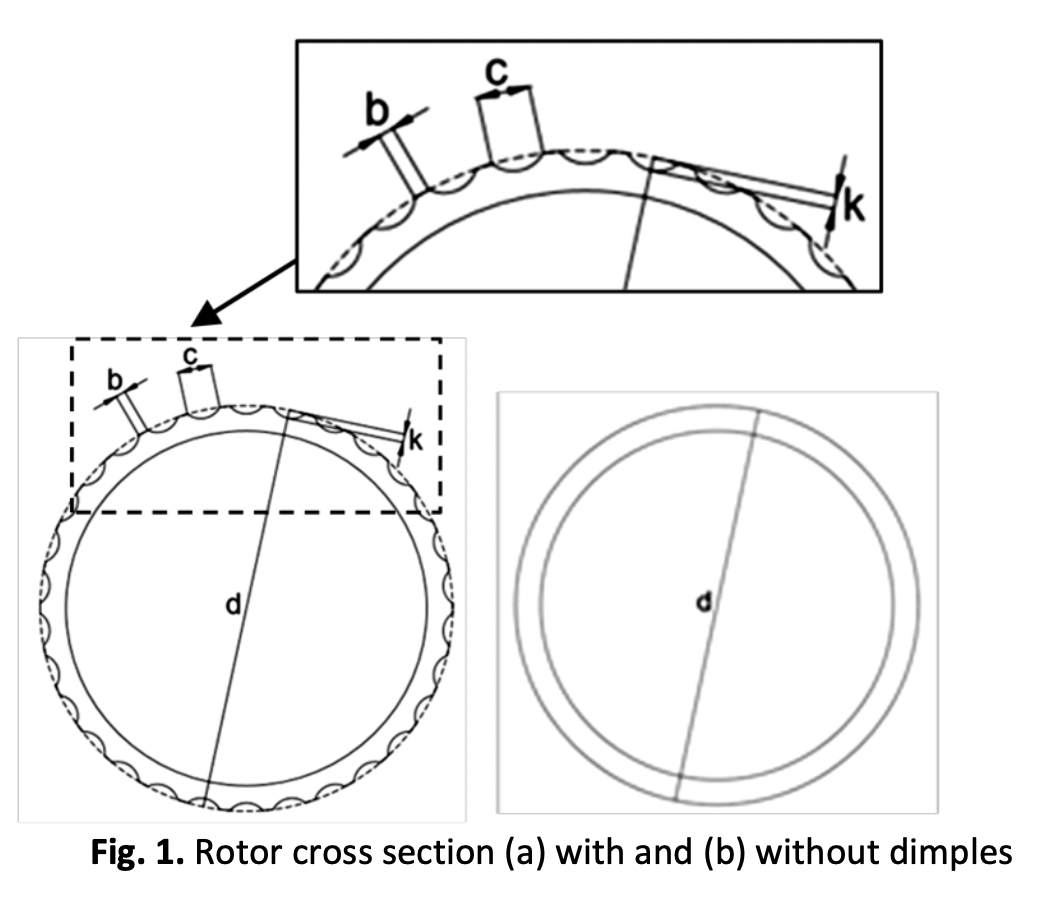The Dimple Effect on Flettner Rotors for the Wind Power Drive System of a Sailing Merchant Ship
DOI:
https://doi.org/10.37934/cfdl.16.2.7690Keywords:
flettner rotor, wind power drive system, computational fluid dynamic, dimpled surface, sailing shipAbstract
Wind-powered ship propulsion is investigated in relation to reducing ship exhaust emissions, such as the application of Flettner rotor systems. How to increase rotor thrust's contribution to ship speed is an intriguing research question. This paper investigates the influence of dimples on the surface of a Flettner rotor on its ability to generate thrust for a ship. The CFD code, which includes the Reynolds average Navier-Stokes equation and the k-ω model for turbulent flow, is utilized to analyse three rotor designs: one with a smooth surface and two with dimple surfaces of varying diameters. Lift and drag are computed by taking into account varying spin ratios and the incoming wind angle. The CFD results are validated by comparing them to experimental data gathered in a wind tunnel and determining that their error is less than 5%. The addition of dimpled surfaces to the rotor increases lift by 69.6% and decreases drag by 14.8% due to the smooth surface. For the case study, the two rotors are mounted on the sailing ship 900 DWT and can generate the most thrust to give the ship a speed of 8.5 knots with a spin ratio of 4 and apparent wind angles of 90o or 270o relative to its speed.
Downloads
References
Yoshimura, Yasuo. "A prospect of sail-assisted fishing boats." Fisheries science 68, no. sup2 (2002): 1815-1818. https://doi.org/10.2331/fishsci.68.sup2_1815
Schmidt, A. Enercon E. "Ship 1 A Wind-Hybrid Commecial Cargo Ship." In Proceedings of the 4th Conference on Ship Efficiency, pp. 23-24. 2013.
Sulisetyono, Aries. "The evaluation of a rigid sail of ship using wind tunnel test." Applied Mechanics and Materials 493 (2014): 287-293. https://doi.org/10.4028/www.scientific.net/AMM.493.287
Bergeson, Lloyd, and C. Kent Greenwald. "Sail assist developments 1979–1985." Journal of wind engineering and industrial aerodynamics 19, no. 1-3 (1985): 45-114. https://doi.org/10.1016/0167-6105(85)90056-X
Prandtl, Ludwig. ”The Magnus effect and wind-powered ships.” Naturwissenschaften, vol. 13, (1925): 1787–1806.
Seybold, G. S. "A sailing ship without sails: new wonder of the seas." Popular Science Monthly 106, no. 2 (1925): 35-37.
De Marco, Agostino, Simone Mancini, Claudio Pensa, Giuseppe Calise, and Fabio De Luca. "Flettner rotor concept for marine applications: A systematic study." International Journal of Rotating Machinery 2016 (2016). https://doi.org/10.1155/2016/3458750
Mgaidi, A. M., Azmin Shakrine Mohd Rafie, Kamarul Arifin Ahmad, Rizal Zahari, Mohd Faisal Abdul Hamid, and Omar Faruqi Marzuki. ”Numerical and experimental analysis of the flow around a rotating circular cylinder at subcritical regime of Reynolds number using K-E and K-Ω-SST turbulent models.” ARPN Journal of Engineering and Applied Sciences, vol. 13, no. 3, (2018): 954-960.
Li, Boyang, Rui Zhang, Yajing Li, Baoshou Zhang, and Chao Guo. "Study of a new type of Flettner rotor in merchant ships." Polish Maritime Research (2021). https://doi.org/10.2478/pomr-2021-0003
Zhou, Bo, Xikun Wang, Wei Guo, Wie Min Gho, and Soon Keat Tan. "Control of flow past a dimpled circular cylinder." Experimental Thermal and Fluid Science 69 (2015): 19-26. https://doi.org/10.1016/j.expthermflusci.2015.07.020
Bearman, P. W., and J. K. Harvey. "Control of circular cylinder flow by the use of dimples." AIAA journal 31, no. 10 (1993): 1753-1756. https://doi.org/10.2514/3.11844
Butt, Usman, Lothar Jehring, and Christoph Egbers. "Mechanism of drag reduction for circular cylinders with patterned surface." International journal of heat and fluid flow 45 (2014): 128-134. https://doi.org/10.1016/j.ijheatfluidflow.2013.10.008
Yahaya, Wan Mohamad Aiman Wan, Syahrullail Samion, Fazila Mohd Zawawi, Mohd Nor Musa, and Muhammad Naim Aiman Najurudeen. "The evaluation of drag and lift force of groove cylinder in wind tunnel." Journal of Advanced Research in Fluid Mechanics and Thermal Sciences 68, no. 2 (2020): 41-50. https://doi.org/10.37934/arfmts.68.2.4150
Aoki, Katsumi, Koji Muto, and Hiroo Okanaga. "Aerodynamic characteristics and flow pattern of a golf ball with rotation." Procedia Engineering 2, no. 2 (2010): 2431-2436. https://doi.org/10.1016/j.proeng.2010.04.011
Tantin, Titik Rus. "Analisa system propulsi berpenggerak motor listrik pada kapal klas Maruta Jaya 900 DWT." PhD diss., Institut Teknologi Sepuluh Nopember, 2005.
Marchaj, C. A. (1964) Sailing Theory and Practice, Dodd Mead & Company, New York, United States.
Versteeg, Henk Kaarle, and Weeratunge Malalasekera. An introduction to computational fluid dynamics: the finite volume method. Pearson education, 2007.
Wilcox, D. C. (1998) Turbulence Modeling for CFD. 2nd edition, DCW Industries, Inc., La Canada CA.
Aliffrananda, M. H., Aries Sulisetyono, Yuda Apri Hermawan, and Achmad Zubaydi. "Numerical analysis of floatplane porpoising instability at calm water during take-off." International Journal Technology 13, no. 1 (2022): 190-201. https://doi.org/10.14716/ijtech.v13i1.4903
Sulisetyono, Aries, And Rinaldi E. Wardhana. "The Resistance Evaluation Of The Autonomous Underwater Vehicle (Auv) Using The Low Speed Wind Tunnel Test." Journal Of Engineering Science And Technology 17, No. 6 (2022): 4355-4366.
Anwar, Shoaib, Md Ibrahim Khalil, and Sumon Saha. "Finite Element Analysis on Turbulent Flow Over Two Side-by-Side Rotating Cylinders." In Proceedings of the 11th International Conference on Computer Modeling and Simulation, pp. 107-111. 2019. https://doi.org/10.1145/3307363.3307380




























